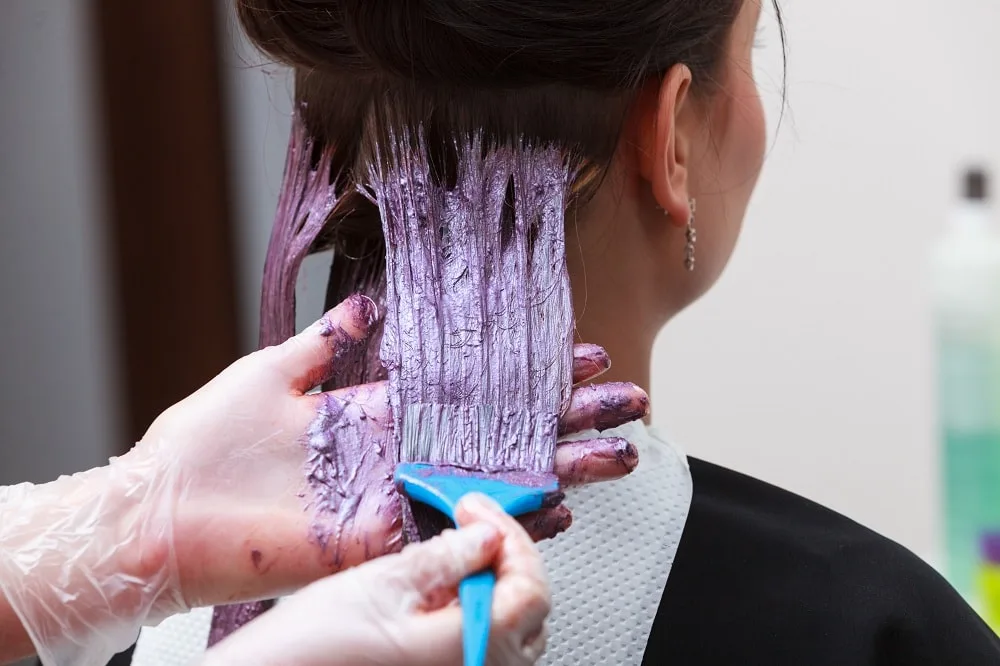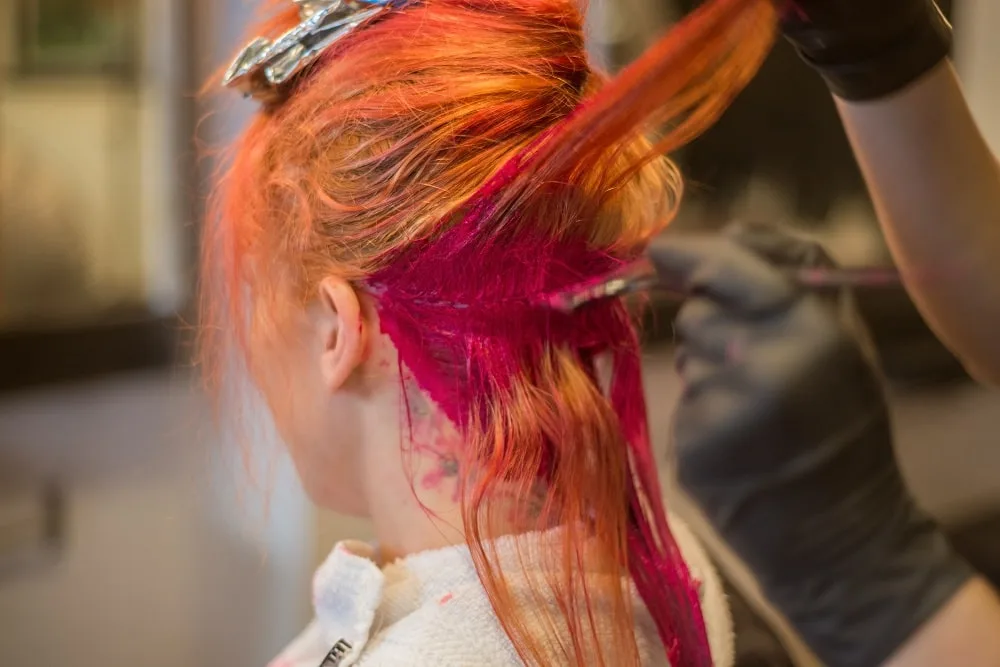Unless you’re a hairstylist by career, you probably are confused about the differences between single-process hair color and double-process hair color.
If you’re skeptical about what’s best for your hair, we’ll compare single-process vs double-process hair color to help you make an informed decision at your next salon appointment.
Difference Between Single-Process and Double-Process Hair Color At A Glance
If you’re in a hurry, here’s a quick look at the Single-Process vs Double-Process hair color comparison table.
|
Single-Process Hair Color |
Double-Processed Hair Color |
|
|
Cost |
Cheaper |
Expensive |
|
Process |
Simple |
Long |
|
When to Use |
Minor changes |
Drastic changes |
|
Maintenance |
Little upkeep |
Regular upkeep |
|
Dye Used |
One color or lightener |
Lightener and color |
|
Examples |
Lowlights |
Fashion colors |
What Is a Single Process Hair Color?
Single-process hair color is when your stylist uses one color from root to tip. It’s a great way to achieve an all-over color that’s uniform in tone. The natural hair color is lifted and a new color is deposited in one step, so it’s a much faster process that can also help you save money in the salon.
Single-process hair color is the most common color treatment done in salons, and it’s perfect for those looking to switch up their natural hair color with a simple and uncomplicated process.

Single Process Hair Color
Within the category of single-process hair color, you can choose various types of coloring, including highlights, lowlights, gradual lightening, or gray coverage.
Covering Grays
Single-process hair color is also a good option for those who want to cover their grays. Since this color process only uses one product, it can be less harsh on the hair and won’t require as much upkeep as other coloring methods. It also usually only involves a root touch-up and doesn’t apply to the entire head.
Gradual Lightening
Gradual lightening is a single-process hair color perfect for those who want to go lighter but don’t want to commit to a complete color change.
In this case, the stylist will paint on a lightener but won’t leave it on for too long. Rather, this approach requires several appointments but can keep hair strands healthier throughout the process.
Highlights & Lowlights

For highlights to be a single-process color, the hair should be virgin or not overly processed if colored before.
Usually, the hair artist will lighten the pieces of your hair you want highlighted using a technique such as balayage or foiling and then using toners to get the hair to the final desired color.
You might ask, “Does toning the hair change it from a single-process to a double-process color?”
The answer is no. While it might be confusing, it’s not adding any more pigment but instead counteracts unwanted pigment, adds shine, and enhances certain tones.
Lowlights are the opposite of highlights. They’re darker than your natural hair color. Hair stylists can also do lowlights in a single process since it doesn’t require any bleaching of the original hair color to achieve the new color.
The lowlighted pieces of hair are dyed a shade or two darker than your desired final color, and then toners are used to even everything out.
Pros and Cons of Single-Process Color
There are advantages and disadvantages to single-process color, here’s what to consider when you decide what’s right for you:
What’re the advantages of Single-process hair color?
- Less expensive than double-process color
- The color tends to be more natural looking because the hair is only lightened so much
- It can be less damaging to hair since there’s only one chemical process involved
What’re the drawbacks of Single-process hair color?
- Your stylist won’t be able to make as drastic of a change since they’re only using only one color
- It can be difficult to achieve an evenly dyed head of hair with single-process color if your hair is very long or thick
If saving time, money, and the health of your hair are more important to you than drastic results from one trip to the salon, a single-process color might be a good place to start.
What Is Double Process Hair Color?
Double-process hair color is when your stylist uses two colors on your hair, usually a lightener such as ammonia or hydrogen peroxide followed by a deposit of color, known as “bleach and color.”
Because this double-process hair color requires bleaching, it can be more damaging to the hair and is usually more expensive than single-process color.
However, it provides much bolder results than single-process hair color can. The most common type of double-process color is going from a darker tone to a much lighter tone, like a natural brunette who wants to go platinum blonde.

Double Process Hair Color
Double-process hair color is also a great option when clients want fashion colors in their hair or need corrective color work done.
All Over Lightening
For double-process hair color, a hair stylist first lightens the strands using bleach or a lightener. They must leave the bleach on for a long time, much longer than for single-process color.
The stylist will pay close attention to the hair as it goes through the various stages of warmth to reach the ideal result. The hair may need to be processed with bleach one or more times to reach the desired color.
Once the hair is lightened to the desired level, the hairstylist will add pigment or toners to even out the color and add shine.
Fashion Colors

Fashion colors are any hair color outside of the natural hair color spectrum, like blue, green, purple, pink, and more. To achieve bold colors, bleaching is usually required to remove the natural pigment from the hair.
Once the stylist lightens the hair to a pale blonde shade, they can start using direct dyes to add in the desired color. The bolder you want the final color to be, the lighter the base of the hair needs to be.
You may need to have your hair lightened, washed, dried, and lightened once more before any color gets deposited.
Corrective Color
Corrective color is when a stylist needs to “fix” a client’s hair color.
You could need a corrective coloring service because you don’t like your previous color, the color turned out differently than you wanted, or your hair got damaged from a previous coloring experience.
In these cases, the stylist may need to lighten the hair first then deposit color to even everything out.
Pros and Cons of Double-Process Hair Color
Learn the pros and cons of double-processed hair color if you want a bolder look in just one visit:
What’re the advantages of Double-process hair color?
- It can provide much bolder results than single-process color.
- Good for those who want fashion colors or need corrective color work.
What’re the drawbacks of Double-process hair color?
- More expensive than single-process color
- The long bleaching process can be damaging to hair
- Requires more upkeep
- Takes longer
- Stronger impact on the structure of the hair
If you don’t mind the extra time or money and care more about immediate results, consider double-process hair color.
What Does Single-Processed and Double-Processed Hair Color Look Like?

Wondering how your hair would look after a single-process color compared to a double-process color?
With single-process color, your stylist will use one color all over your head to achieve an even tone. Single-process color is a good option if you just want to cover up some gray hair or want to add dimension to your natural hair color.
Single-process color can also be used to lighten or darken your hair by a few shades. Overall, it won’t look drastically different from your original tone but can adjust it slightly.
Double-process color is much more dramatic because it involves lightening your hair first and then adding in the desired color.
Double-process color can be used to drastically change your hair color, like going from a dark brown to a platinum blonde. It can also be used to add fashion colors like blue or purple.
Major Differences Between Single and Double Processed Hair Color
When it comes to single and double-processed hair color, there are a few key differences. Here’s what you should know about each type of hair color:
Cost
Single-process color is generally cheaper because it uses one color and doesn’t require bleaching. Double-process color is more expensive because it uses two colors (bleach and pigment) and takes more time.
Process
Single-process color involves applying one color all over the head or making slight changes to the color or tone with bleach. Double-process color involves bleaching the hair first and then adding in the desired color.
When to Use
Single-process color can be used to make small changes to your hair color or give your hair some dimension. Double-process color is best for those who want a drastic change, like going from dark brown to blonde.
Maintenance
Single-process color is more low-maintenance because it doesn’t require as much upkeep.
Double-process color is more high-maintenance because the hair needs to be bleached regularly to maintain the desired color, usually every 4-5 weeks.
Dye Used
Single-process color uses one color, while double-process color uses two colors (bleach and pigment).
Examples
Some examples of single-process colors are slight highlights, lowlights, root touch-ups, and all-over hair color.
Some examples of double-process color are going platinum blonde, adding fashion colors, or color correction treatments.
Overall, there are a few key differences between single and double-processed hair color. Single-process color is generally cheaper, doesn’t require as much upkeep, and uses one color.
Double-process color is more expensive, requires more maintenance, and uses two processes – a lightener and a pigment.
When deciding which type of hair color is right for you, consider your budget, how much time you’re willing to spend on upkeep, and the overall look you’re going for.
